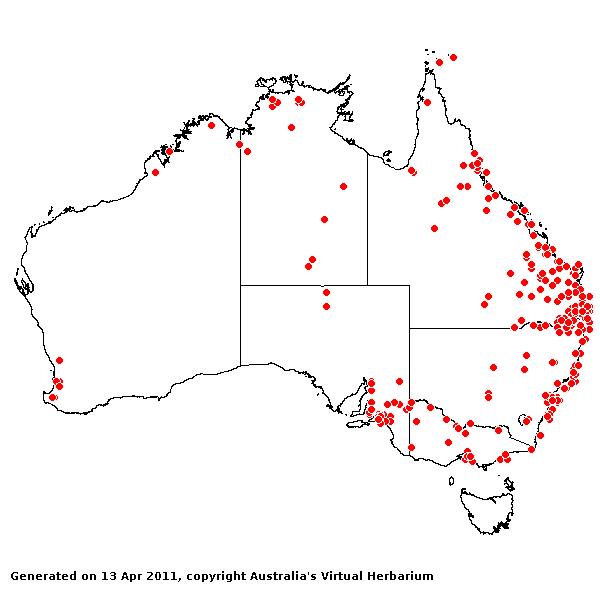Chloris gayana* Kunth. Rev. Gram.1: 293 (1830).
Classification. (GPWG 2001) : Subfamily Chloridoideae. Cynodonteae.
Type of Basionym or Protologue Information: ST: Herb. Gay 40, 4 Feb 1823, Senegal (K, P).
Key references (books and floras): [1952] C.A.Gardner, Flora of Western Australia 1 Gramineae (220), [1969] E.E.Henty, Manual Grasses New Guinea (50), [2002] D.Sharp & B.K.Simon, AusGrass, Grasses of Australia, [2006] J.Jessop, G.R.M.Dashorst, F.M.James, Grasses of South Australia (344), [2008] S.W.L.Jacobs, R.D.B.Walley & D.J.B.Wheeler, Grasses of New South Wales (183).
Illustrations: [1983] J.C.Tothill & J.B.Hacker, Grasses of Southern Queensland (154 & 156(4)), [2005] K.Mallet (ed.), Flora of Australia 44B: Poaceae 3 (Fig. 44E), [2006] J.Jessop, G.R.M.Dashorst, F.M.James, Grasses of South Australia (344, Fig. 275), [2008] S.W.L.Jacobs, R.D.B.Whalley & D.J.B.Wheeler, Grasses of New South Wales, 4th edn (183).
Habit. Perennial. Stolons absent or present. Culms erect or geniculately ascending, 45–220 cm tall. Ligule a fringed membrane, a ciliolate membrane or a ciliate membrane, 0.4–0.6 mm long. Leaf-blades 14–50 cm long, (1.5–)3–9 mm wide.
Inflorescence. Inflorescence digitate, with spicate branches.
Spikelets. Spikelets sessile. Fertile spikelets 1 or more flowered, with 1 fertile floret (1–4), comprising 1–4 fertile floret(s), with diminished florets at the apex, cuneate, laterally compressed, 2.5–4 mm long.
Glumes. Glumes similar, thinner than fertile lemma. Lower glume lanceolate, membranous, keeled, 1-keeled, 1 -nerved. Upper glume lanceolate, 2–4 mm long, membranous, keeled, 1-keeled, 1 -nerved. Upper glume surface smooth.
Florets. Fertile lemma 2.5–3.5 mm long, keeled, 3 -nerved. Lemma apex entire or lobed, awned, 1 -awned. Median (principal) awn subapical, 2–10 mm long overall. Lodicules present. Anthers 3.
Continental Distribution: Africa, Temperate Asia, Tropical Asia, Australasia, Pacific, North America, and South America.
Australian Distribution: Western Australia, Northern Territory, South Australia, Queensland, New South Wales, Victoria, Norfolk I, Lord Howe.
Western Australia: Drummond, Menzies, Roe, Avon. Northern Territory: Darwin & Gulf. South Australia: Yorke Peninsula, Southern Lofty, South-eastern. Queensland: Burke, Burnett, Darling Downs, Gregory North, Leichhardt, Maranoa, Moreton, North Kennedy, South Kennedy, Warrego, Wide Bay, Cook, Port Curtis. New South Wales: North Coast, Central Coast, South Coast, Northern Tablelands, North-Western Slopes, South-Western Slopes, South-Western Plains. Victoria: Gippsland Plain, Murray Mallee, Riverina, Volcanic Plain.
Notes. Has been used as a soil binder, being drought- and salt-tolerant and stoloniferous. Cultivated for fodder and shelter.
Introduced; cultivated or naturalized throughout the more settled areas of Australia such as the E coast (except Cape York Penin.), the Murraylands, southern Vic., around Darwin, N.T. and the SE of W.A.; particularly widespread in Qld; introduced from Africa into tropical Asia and the New World. Most often found on roadsides and other disturbed areas, C. gayana prefers heavy black or grey soils, but is also found on sandy and reddish-brown loamy soils. It may occur in dense stands or with other, usually introduced grasses, in grassland, shrubland or open forest.








